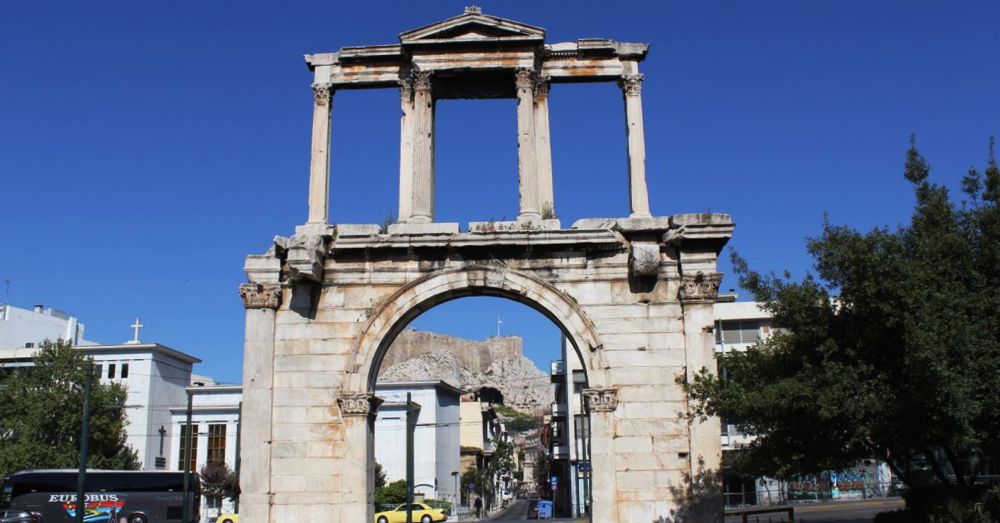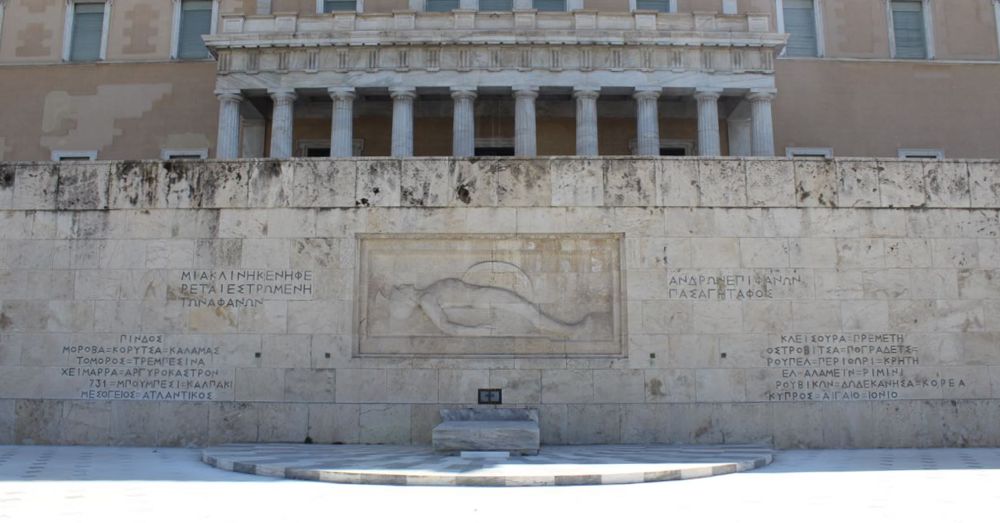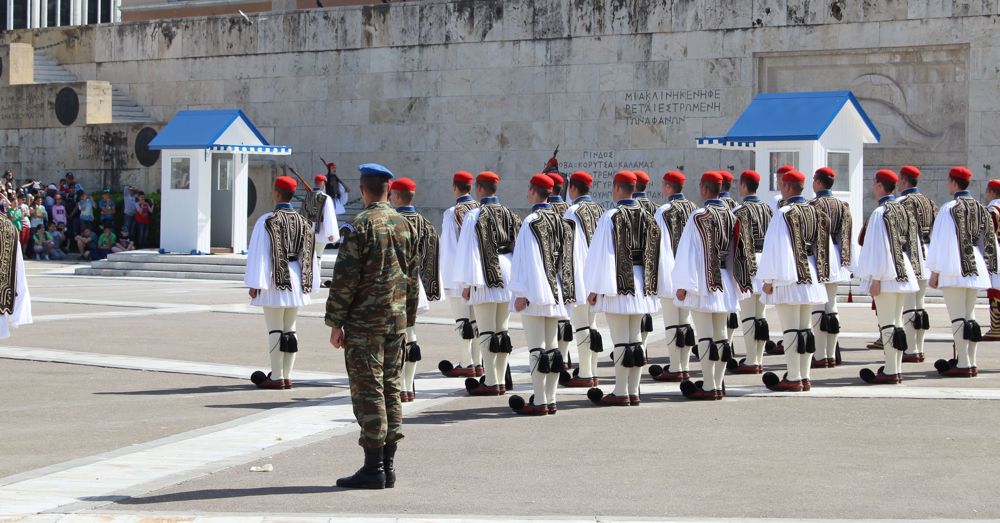Thursday, 16-04-2015 — Sunday, 19-04-2015.
Day 239 — Day 242.
Our day started in Barcelona with an early morning plane ride to Athens. The whole flight was fairly uneventful, although the seats the Vueling flight were pretty cramped. But by Noon we had landed in Athens, Greece.
We used a service called Welcome Pickups, a service that provides a taxi from the airport for a flat fee. As an additional feature, the driver speaks English and during the drive to the city will give you hints and tips about where to go and what to do. It’s a great service, and our driver, Alekos, gave us a lot of good tips for authentic Greek dishes (including local beers) to try.
Museum of the Acropolis
We read there was a free walking tour of Athens every day at 10:00 a.m., and we were planning on taking it the next morning. We had a little time after we got settled into our apartment, so we walked up to the Museum of the Acropolis to make sure we could find the yellow mailbox where the tour started.
As long as we were there, we decided to check the museum. When we visited, the building was relatively new. As they were building it, they stumbled across some ruins of an ancient Athenian neighborhood (which seems to happen a lot in Greece). But unlike other places, where they relocated the construction, they built the museum right on top of the ancient neighborhood. As you walk into the museum, you can see the remarkably preserved old neighborhood underneath your feet through a glass floor. It was pretty cool.
Inside, the museum itself gave a pretty good overview of the history of the Acropolis, and there were a lot of statues and pieces of marble on display, but many of them were placed in a way that didn't seem tell any sort of story relative to each other. The layout of the museum could best be described as, “All this stuff in here, it used to be over there.”
You are allowed to photograph some things but not others at the museum, but the exhibits aren’t that clearly labelled as to which can be photographed and which cannot, so I didn’t take many pictures. I did figure the Lego Acropolis was a safe bet, though.
Free Athens Walking Tour
The next morning, after a quick breakfast, the first agenda item on our first full day in Athens was a the free, 3-hour walking tour that started right at 10:00 a.m. From our meeting spot at the museum, our group of about 20 walked over to the Arch of Hadrian, which was built to honor Roman Emperor Hadrian for all the good things he’d done for Athens, including finally allowing the the nearby Temple of Olympian Zeus to be completed.
The west side of the Arch is inscribed with “This is Athens formerly the city of Theseus” while the east side reads “This is the city of Hadrian and not Theseus.” There’s some controversy over what this means, exactly. Some scholars believe it to be a dividing line between the old and new parts of the ancient city, while others believe it honored the unification of Athens under Hadrian’s rule.
After a brief look at the Temple of Olympian Zeus (a place we would investigate on our own later), we walked to the Panathenaic Stadium, the world's only all-marble stadium and the location of the first modern Olympic Games in 1896. It is named for the length of the stadium, which is about 185 meters.
We only got a glimpse of it from the outside, but we'd return to it later during out stay in Athens when we got the chance to run a lap on the track, which was pretty cool. The stadium is located on the site of an earlier ancient stadium dating back to 330 BC where nude male athletes competed.
At the far end of the track, there are some statues that are male busts on square columns. One of those columns, however has penises sticking out of it. I’m guessing this is a homage to the nude male athletes of yore. But it was really weird looking.
A quick walk later had us looking at the Zappeion, a very Greek-style building where the first and only Intercalated Games were held in 1906.
These games, which had been in the planning since 1901, were created to fill the gap in the even years between Olympic Games. The idea never quite took off, and after a few years of planning the whole concept was abandoned (World War I was one of the contributing factors in its demise).
But even though the Intercalated Games never quite took off, the tradition of the Olympic Village, a tradition that continues to this day, started here.
The place is called the Zappeion after two cousins, Evangelos Zappas and Konstantinos Zappas, who were instrumental in bringing about the modern Olympic Games. They are also supposedly distantly related to Frank Zappa.
We walked through some gardens and on to the Parliament Building where the famous Evzoni, or Presidential Guard, keep vigil 24 hours a day. These elite soldiers, don’t guard Parliament, though — a fact which gave our guide the opportunity to crack an economic crisis joke. Rather, they guard the Tomb of the Unknown Soldier.
The Evzoni wear the traditional uniform of an 1800s-era Greek infantryman. Their kilts are said to have 400 pleats, one for each year of Ottoman rule.
Like London's Queen’s Guard and the palace guard in Seoul, these gentlemen don't move while on duty. You’re invited to take pictures with them, but a guard wearing modern fatigues guards the guards and will warn you if you get too close. Our guide told us he only saw one move once, and that was to give someone who was taking a selfie next to him a hard elbow. So don't take selfies with the Evzoni.
There’s an elaborate changing of the guard ceremony they do every Sunday. We were lucky enough to see it a few days later.
After a short break, we continued on to see Hadrian’s Library, or what’s left of it. It was built in 132 and housed countless papyrus scrolls. It was damaged, like everything else in Athens, during the invasion in 267 and about the only thing left standing is one of the walls.
We then walked through the Agora , which houses the Temple of Hephaestus and the Stoa of Attalos, and up the hill to the top of the Areopagus, better known as the Hill of Mars.
At the top of the Hill of Mars, you get great panoramic views of the entire city of Athens, including a nice look at the Acropolis to the southeast. From here our guide showed us the seven hills of Athens, explained their history and what their different uses over the years.
The last stop on our tour was at the Odeon of Herodes Atticus, a 5,000 seat venue (an odeon, has a roof, but the roof here was destroyed in, again, 267) on the southern slope of the Acropolis. It dates back to the year 161. It was restored (somewhat) in the 1950s and since then has been the major venues venue for the Athens Festival, which takes place from May through October.
And that was the end of the tour. We considered heading up to the Acropolis right after our tour ended since we were so close, but some of us were tired of walking, so we went down the hill where we met our new friend Katerina (who works at Welcome Pickups) and her two kids for some ice cream and an enjoyable afternoon.
The Acropolis
The next day we went back to the Acropolis, where, much to our surprise, we learned that admission was free that day.
It takes some walking to get up to the Acropolis, and that walk takes you past a number of excavated sites adjacent to the path that leads up the hill. The first major one visitors encounter is the Theatre of Dionysus.
The theater, which could hold 17,000 spectators in its day, dates back to the fourth century BC. The location is notable because it’s thought to be the birthplace of theater. After sitting on the marble seats for a minute or two, we followed the twisting path up the hill, past views of the Odeon and the sprawling city of Athens, through the Propylaea, and up onto the Acropolis itself.
The Parthenon, the largest and most recognizable building on top of the Acropolis, has been undergoing a hefty restoration project since 1975, and the western face was covered with scaffolding and heavy machinery. But the opposite side was intact and gave a sense of how inspiring the building must have been in its day.
The Caryatids of the Erechtheion
There was so much history here, it was overwhelming. These buildings have survived wars, bombings, explosions, and have served many different functions through time — including temples, churches, and palaces, and even the chambers for harems — depending on who was ruling Athens.
Temple of Olympian Zeus
After we were done with the Acropolis, we walked over to the Temple of Olympian Zeus. We’d visited the place only briefly the day before on our walking tour, but today we were going to go inside. We were surprised and pleased to learn that admission, like the Acropolis, was free. This time we asked why and were told it was April 18, which just happens to be International Monument Day, and many UNESCO World Heritage sites across the globe offer free admission.
The Temple of Olympian Zeus took more than 600 years to build. It began in the days of dictatorship under Athenian tyrants. But when the tyrants were overthrown in 500 BC, work on the temple stopped. It was eventually completed under the rule of Roman Emperor Hadrian, who dedicated the temple himself in the year 132.
Then in 267 the temple was damaged during an invasion of Athens and was likely abandoned from that point on. Over the years, most of the stone that made up the temple has been appropriated for use in other Athenian building projects and now, of its 130 original columns, only 16 remain on the site.
Today, the Temple of Olympian Zeus is where the Olympic torch is lit for the Winter Olympic Games.
And then it was time to leave
And that was about it, really. Of course we also ate some good Greek food (all the restaurants seemed to offer “crisis pricing”), but with touring, eating, and spending a little time with another world-traveling family, our days in Athens went by pretty quickly. Before we knew it, we were leaving Athens for a relaxing week on Crete.

Tom Fassbender is a writer of things with a strong adventurous streak. He also drinks coffee.























